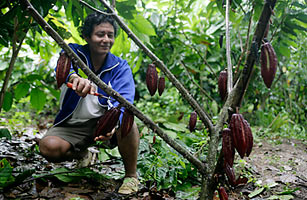
The certificate was only one of several that emerged from the prestigious Salon du Chocolat in Paris, the annual summit of the world’s master chocolatiers. But it may be enough to start a revolution in Peru. In October 2009, chocolate produced from the cacao beans of a small agricultural cooperative deep in one of the country’s rain forests was named the most aromatic in the world by the Salon. “We used to be known for making cocaine paste, but now we are known for chocolate,” says Elena Rios, 52, secretary of the Tocache Agroindustrial Cooperative. Rios herself gave up growing coca leaves 10 years ago, opting to take part in a program to replace her plants with cacao. “There were only 12 of us when we started; now we have hundreds. Our success is contagious. No one wants to grow coca in Tocache. Everyone is thinking about chocolate.”
Indeed, such is the local excitement that Peru’s San Martin department, where Tocache is located, wants to put itself on the map as the chocolate capital of the world. Located in the lush tropics where the Andes mountain range gives way to the northern Amazon rain forest, San Martin has a wilder reputation from its recent past: for years it was a bastion for the rebels of the Tupac Amaru Revolutionary Movement and the much more violent Maoist fighters of the Shining Path. Hand in hand with subversion came drug trafficking, with the surrounding countryside perfect terrain for coca, from which cocaine is processed.
While the two subversive groups have been defeated, San Martin still has some coca — about 800 acres , according to the latest U.N. survey on coca crops — but that is minuscule compared to what it used to cultivate. Coffee and cacao farms have taken hold instead. The U.N. Office on Drugs and Crime talks about a “San Martin model” as a success story for replacing coca with legal crops. Chocolate is leading the way.
“We are working to identify Peru with chocolate, the way Colombia is identified with coffee. We have the world’s best beans,” says Blanca Panizo, who works for the Alternative Development Program, a U.S. Agency for International Development–backed initiative promoting crops to replace coca. San Martin’s top cacao producers hosted a tasting fair in Tarapoto, the department’s largest city, in mid-January for a U.S. delegation including Deputy Secretary of State James Steinberg, who was in town for a day. Steinberg walked away with bags of rich, dark chocolate, telling growers that his two daughters loved chocolate.
More important, Steinberg told them the U.S. would remain on their side in the long process of replacing coca with legal crops. He said alternative development programs “must involve the communities, giving them ownership and the ability to shape programs. The strategy in San Martin has a lot of promise.”
Peru is the world’s second largest coca producer after Colombia, with nearly 139,000 acres covered by the crop, according to the UNODC. While land dedicated to coca has declined noticeably in San Martin, it has increased nationwide throughout the last decade. Eradication brigades eliminated around 25,000 acres last year. A similar amount is targeted for 2010.
Nevertheless, cacao exports were up over 400% in the past decade, and production this year will be around 35,000 metric tons, putting Peru close to the top 10 biggest producers. The U.S. program invested more than $110 million in alternative development plans in Peru in the past decade. The program involves nearly half of the 150,000 acres of cacao planted in the country. The goal is to expand not only in San Martin but throughout the country’s tropics. About 60% of Peru’s territory is jungle.
If the plan works, there will be chocolate for all tastes. The U.S. Department of Agriculture is working with a local research center in San Martin, the Institute for Tropical Crops , to identify new varieties of cacao beans. The institute is studying 342 specimens collected from 12 watersheds. “We are working on categorizing the DNA of cacao,” says ITC director Enrique Arevalo. The work will eventually lead to the creation of a Peru-specific chocolate that could be marketed the way countries sell wine. Hiderico Bocangel, general manager of San Martin’s Oro Verde cooperative, says Peru is already creating a niche in the chocolate world. “We have the perfect conditions here to produce exceptional chocolate,” he says.
There is, of course, stiff competition. Neighboring Ecuador already has a jump on Peru, pushing for its “national” or arriba bean to be granted geographic indication — or certified origin — just like French Champagne. There are five chocolatiers in Ecuador marketing chocolate based on origin and organic production. They have USDA organic certificates and can be found in supermarket chains in the U.S. Peruvian chocolate producers have not gotten that far. “Our job is to get the word out,” says Bocangel. “This visit [by the Steinberg delegation] is important for us to do that.”
Watch a video on the bacon chocolate bar.
Read a TIME postcard on the world’s best chocolate.